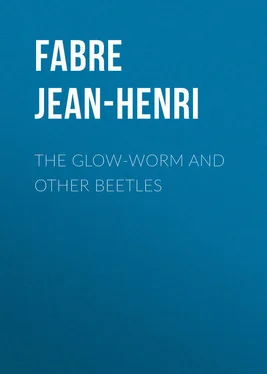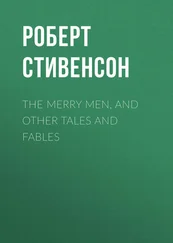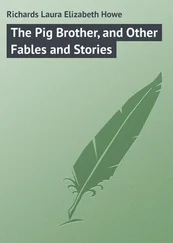Jean-Henri Fabre - The Glow-Worm and Other Beetles
Здесь есть возможность читать онлайн «Jean-Henri Fabre - The Glow-Worm and Other Beetles» — ознакомительный отрывок электронной книги совершенно бесплатно, а после прочтения отрывка купить полную версию. В некоторых случаях можно слушать аудио, скачать через торрент в формате fb2 и присутствует краткое содержание. Жанр: foreign_antique, foreign_prose, на английском языке. Описание произведения, (предисловие) а так же отзывы посетителей доступны на портале библиотеки ЛибКат.
- Название:The Glow-Worm and Other Beetles
- Автор:
- Жанр:
- Год:неизвестен
- ISBN:нет данных
- Рейтинг книги:5 / 5. Голосов: 1
-
Избранное:Добавить в избранное
- Отзывы:
-
Ваша оценка:
- 100
- 1
- 2
- 3
- 4
- 5
The Glow-Worm and Other Beetles: краткое содержание, описание и аннотация
Предлагаем к чтению аннотацию, описание, краткое содержание или предисловие (зависит от того, что написал сам автор книги «The Glow-Worm and Other Beetles»). Если вы не нашли необходимую информацию о книге — напишите в комментариях, мы постараемся отыскать её.
The Glow-Worm and Other Beetles — читать онлайн ознакомительный отрывок
Ниже представлен текст книги, разбитый по страницам. Система сохранения места последней прочитанной страницы, позволяет с удобством читать онлайн бесплатно книгу «The Glow-Worm and Other Beetles», без необходимости каждый раз заново искать на чём Вы остановились. Поставьте закладку, и сможете в любой момент перейти на страницу, на которой закончили чтение.
Интервал:
Закладка:
At the moment of the pairing, the illumination becomes much fainter, is almost extinguished; all that remains alight is the humble fairy-lamp of the last segment. This discreet night-light is enough for the wedding, while, all around, the host of nocturnal insects, lingering over their respective affairs, murmur the universal marriage-hymn. The laying follows very soon. The round, white eggs are laid, or rather strewn at random, without the least care on the mother's part, either on the more or less cool earth or on a blade of grass. These brilliant ones know nothing at all of family-affection.
Here is a very singular thing: the Glow-worm's eggs are luminous even when still contained in the mother's womb. If I happen by accident to crush a female big with germs that have reached maturity, a shiny streak runs along my fingers, as though I had broken some vessel filled with a phosphorescent fluid. The lens shows me that I am wrong. The luminosity comes from the cluster of eggs forced out of the ovary. Besides, as laying-time approaches, the phosphorescence of the eggs is already made manifest without this clumsy midwifery. A soft opalescent light shines through the skin of the belly.
The hatching follows soon after the laying. The young of either sex have two little rush-lights on the last segment. At the approach of the severe weather, they go down into the ground, but not very far. In my rearing-jars, which are supplied with fine and very loose earth, they descend to a depth of three or four inches at most. I dig up a few in mid-winter. I always find them carrying their faint stern-light. About the month of April, they come up again to the surface, there to continue and complete their evolution.
From start to finish, the Glow-worm's life is one great orgy of light. The eggs are luminous; the grubs likewise. The full-grown females are magnificent light-houses, the adult males retain the glimmer which the grubs already possessed. We can understand the object of the feminine beacon; but of what use is all the rest of the pyrotechnic display? To my great regret, I cannot tell. It is and will be, for many a day to come, perhaps for all time, the secret of animal physics, which is deeper than the physics of the books.
CHAPTER II
THE SITARES
The high banks of sandy clay in the country round about Carpentras are the favourite haunts of a host of Bees and Wasps, those lovers of a thoroughly sunny aspect and of soils that are easy to excavate. Here, in the month of May, two Anthophoræ 4 4 Cf. The Mason-bees , by J. Henri Fabre, translated by Alexander Teixeira de Mattos: chap. viii.; and Bramble-bees and Others , by J. Henri Fabre, translated by Alexander Teixeira de Mattos: passim . — Translator's Note .
are especially abundant, gatherers of honey and, both of them, makers of subterranean cells. One, A. parietina , builds at the entrance of her dwelling an advanced fortification, an earthy cylinder, wrought in open work, like that of the Odynerus, 5 5 Cf. The Mason-wasps , by J. Henri Fabre, translated by Alexander Teixeira de Mattos: chaps. vi. and x. — Translator's Note .
and curved like it, but of the width and length of a man's finger. When the community is a populous one, we stand amazed at the rustic ornamentation formed by all these stalactites of clay hanging from the façade. The other, A. pilipes , who is very much more frequent, leaves the opening of her corridor bare. The chinks between the stones in old walls and abandoned hovels, the surfaces of excavations in soft sandstone or marl, are found suitable for her labours; but the favourite spots, those to which the greatest number of swarms resort, are vertical stretches, exposed to the south, such as are afforded by the cuttings of deeply sunken roads. Here, over areas many yards in width, the wall is drilled with a multitude of holes, which impart to the earthy mass the look of some enormous sponge. These round holes might be fashioned with an auger, so regular are they. Each is the entrance to a winding corridor, which runs to a depth of four to six inches. The cells are distributed at the far end. If we would witness the labours of the industrious Bee, we must repair to her workshop during the latter half of May. Then, but at a respectful distance, if, as novices, we are afraid of being stung, we may contemplate, in all its bewildering activity, the tumultuous, buzzing swarm, busied with the building and the provisioning of the cells.
It is most often during the months of August and September, those happy months of the summer holidays, that I have visited the banks inhabited by the Anthophora. At this period all is silent near the nests; the work has long been completed; and numbers of Spiders' webs line the crevices or plunge their silken tubes into the Bee's corridors. Let us not, however, hastily abandon the city once so populous, so full of life and bustle and now deserted. A few inches below the surface, thousands of larvæ and nymphs, imprisoned in their cells of clay, are resting until the coming spring. Might not such a succulent prey as these larvæ, paralysed and incapable of defence, tempt certain parasites who are industrious enough to attain them?
Here indeed are some Flies clad in a dismal livery, half-black, half-white, a species of Anthrax ( A. sinuata ), 6 6 Cf. The Life of the Fly , by J. Henri Fabre, translated by Alexander Teixeira de Mattos: chaps. ii. and iv. — Translator's Note .
flying indolently from gallery to gallery, doubtless with the object of laying their eggs there; and here are others, more numerous, whose mission is fulfilled and who, having died in harness, are hanging dry and shrivelled in the Spiders' webs. Elsewhere the entire surface of a perpendicular bank is hung with the dried corpses of a Beetle ( Sitaris humeralis ), slung, like the Flies, in the silken meshes of the Spiders. Among these corpses some male Sitares circle, busy, amorous, heedless of death, mating with the first female that passes within reach, while the fertilized females thrust their bulky abdomens into the opening of a gallery and disappear into it backwards. It is impossible to mistake the situation: some grave interest attracts to this spot these two insects, which, within a few days, make their appearance, mate, lay their eggs and die at the very doors of the Anthophora's dwellings.
Let us now give a few blows of the pick to the surface beneath which the singular incidents already in our mind must be occurring, beneath which similar things occurred last year; perhaps we shall find some evidence of the parasitism which we suspected. If we search the dwellings of the Anthophoræ during the early days of August, this is what we see: the cells forming the superficial layer are not like those situated at a greater depth. This difference arises from the fact that the same establishment is exploited simultaneously by the Anthophora and by an Osmia ( O. tricornis ) 7 7 Cf. Bramble-bees and Others: passim . — Translator's Note .
as is proved by an observation made at the working-period, in May. The Anthophoræ are the actual pioneers, the work of boring the galleries is wholly theirs; and their cells are situated right at the end. The Osmia profits by the galleries which have been abandoned either because of their age, or because of the completion of the cells occupying the most distant part; she builds her cells by dividing these corridors into unequal and inartistic chambers by means of rude earthen partitions. The Osmia's sole achievement in the way of masonry is confined to these partitions. This, by the way, is the ordinary building-method adopted by the various Osmiæ, who content themselves with a chink between two stones, an empty Snail-shell, or the dry and hollow stem of some plant, wherein to build their stacks of cells, at small expense, by means of light partitions of mortar.
Интервал:
Закладка:
Похожие книги на «The Glow-Worm and Other Beetles»
Представляем Вашему вниманию похожие книги на «The Glow-Worm and Other Beetles» списком для выбора. Мы отобрали схожую по названию и смыслу литературу в надежде предоставить читателям больше вариантов отыскать новые, интересные, ещё непрочитанные произведения.
Обсуждение, отзывы о книге «The Glow-Worm and Other Beetles» и просто собственные мнения читателей. Оставьте ваши комментарии, напишите, что Вы думаете о произведении, его смысле или главных героях. Укажите что конкретно понравилось, а что нет, и почему Вы так считаете.












